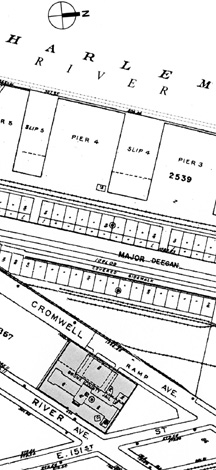The area surrounding the Bronx House of Detention site, alternatively known as West Haven or
Morrisania, was part of the Morrisania estate owned by Lewis Morris during the late 1600s. Before that, it
was part of the property of Jonas Bronck, who purchased the land from its Native American inhabitants
and ultimately lent his name to the borough. The land was sold to the Morris family in the late 1660s, thus
beginning a family presence in the area that would continue for centuries.
Morrisania played a major role in the Revolutionary War. American troops were stationed there after the
city was reclaimed by the British. British troops were forced to retreat to Fordham, but not before they
were given the opportunity to wreak havoc on the area by felling trees and burning homes (Historical
Perspectives 2004).
 | | The image above labed "Site Plan, Figure 3" and the top-of-the-page image labeled "Bronx House of Detention Under Construction Ca. 1936, Figure 3" appear in the HABS documentation in a group of "Figure" pages after the bibliography. |
|
Throughout the late 18th and early 19th centuries, the Bronx remained sparsely settled although there
were several active farms located there which grew produce for the city. One resident, Robert Macomb,
erected a dam across the Harlem River in 1813. The dam, which was constructed to only allow small boats
through a lock system, was torn down by disgruntled Westchester farmers in 1836. The existing steel
Macombs Dam Bridge was constructed in its place in 1895.
Morrisania, West Farms, and Kingsbridge the 23rd and 24th wards were annexed to New York in
1874, and under the New York charter were officially designated the Borough of the Bronx in 1895. The
area’s prominence was established with the extension of the New York and Harlem Railroad from
Manhattan to the area in 1842.
For the first time, a daily commute between the Bronx and lower
Manhattan -- the city proper did not extend north of 14th Street until the mid-l9th century -- became a
realistic, and affordable, option. The area became filled with tenements after the Third Avenue elevated
railroad was constructed. This line entered the Bronx by 1886 and ran down Third Avenue to 177th Street
by 1891.(#1)
This made it even more convenient for workers to commute to jobs in Manhattan. The opening
of the Interborough Rapid Transit (subway) systems in the early 20th century further encouraged large-scale residential migrations.
By 1905, Morrisania’s population had grown to approximately 60,000 residents. The construction of the
Grand Concourse between 1902 and 1909 created a main thoroughfare that became the borough’s parade
route, the site of its government offices, and an important shopping and entertainment district. Yankee
Stadium was built in 1923, north of the project site, bringing the Yankees across the Harlem River from
their former home at the Polo Grounds.
 | | The above image -- showing parts of the Harlem River, the piers, the Major Deegan, Cromwell and River Avenues, and East 151st St. -- is based on a detail section of the map at the top of preceding web page in this NYCHS presentation. A downloadable and printable 100 dpi 422 Kb PDF Adobe Acrobat image of that HABS map can be accessed by clicking the above detail section. |
|
The construction of Yankee Stadium as well as the development
of department stores, boutiques, and restaurants soon made Morrisania the civic and social center of the
borough. Later additions to the area included the main Post Office in the 1930s, Eugenio Maria de Hostos
Community College in the 1960s, and Lincoln Hospital in the 1970s.
Another major change to the area came with construction of the Major Deegan Expressway. The section of
the Expressway linking the Grand Concourse with the Westchester County border and Interstate 87, which
includes the portion of the Expressway within the Bronx House of Detention area, was undertaken in 1950
and was completed in 1956. In the mid-1990s, the Oak Point Link rail connection was built on a trestle
along the Harlem River near the project site, parallel to the shoreline.
In the Bronx House of Detention area, the original shoreline of the Harlem River ran in the vicinity of
what has since become Cromwell Avenue. (#2)
Landfilling occurred in the 1890s, at the same time that
Harlem River piers and bulkheads were constructed. Significant development in the area did not begin
until the I 880s, when the first buildings on what is now the Bronx Terminal Market site were erected,
including a refrigerator manufacturing building at the northwest corner of River Avenue and 150th Street

